Family name: Velloziaceae J. Agardh
Synonym(s): Acanthochlamydaceae P. C. Kao
Common name(s): vellozia family
*Number of genera/species: 4/306
List of genera records in GRIN-Global
seed
Fruit dehiscent, anomalicidalanomalicidal:
type of capsular dehiscence, opening irregularly
or loculicidalloculicidal:
type of capsular dehiscence, opening longitudinally through the locules (compare septicidal)
 capsulecapsule:
capsulecapsule:
a dry, dehiscent fruit formed by two or more carpels
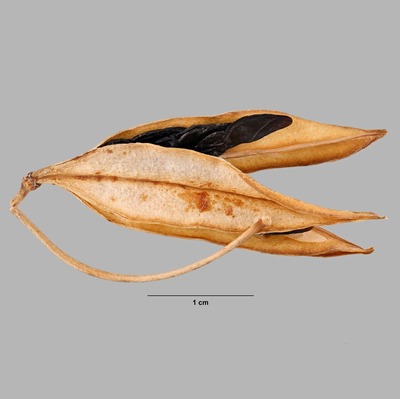 , 10–30 mm long, globoseglobose:
, 10–30 mm long, globoseglobose:
3D shape—more or less spherical
 to oblongoblong:
to oblongoblong:
2D shape—much longer than broad with nearly parallel sides, corners are rounded , roundround:
, roundround:
2D shape—orbiculate; circular in transectiontransection:
in transectiontransection:
a cross section; representing a plane made by cutting across an organ at a right angle to its length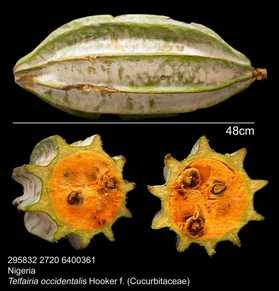 , many seeded. Pericarppericarp:
, many seeded. Pericarppericarp:
fruit wall or fruit coat
smooth, ribbedribbed:
surface relief—wide, prominent, linear ridges that are generally rounded and longitudinally situated on the surface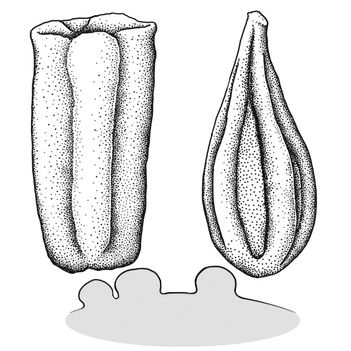 or wartywarty:
or wartywarty:
surface relief—distinct, rounded projections that are large relative to the fruit size; tuberculate, verrucose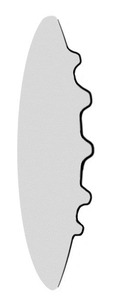 , sometimes pubescentpubescent:
, sometimes pubescentpubescent:
surface relief—bearing hairs
. CapsulesCapsules:
a dry, dehiscent fruit formed by two or more carpels
 are sticky especially if humidity is high.
are sticky especially if humidity is high.
Seed polygonalpolygonal:
=angular
, cuneiformcuneiform:
=wedge-shaped
, or oblongoblong:
2D shape—much longer than broad with nearly parallel sides, corners are rounded , compressedcompressed:
, compressedcompressed:
flattened; in grasses, used to denote compression (not necessarily flattened) either laterally or dorsiventrally
in transectiontransection:
a cross section; representing a plane made by cutting across an organ at a right angle to its length , 5–18 mm long. Seed coat red or black, leatheryleathery:
, 5–18 mm long. Seed coat red or black, leatheryleathery:
texture—moderately thick, tough, and very pliable
or hard, reticulatereticulate:
surface relief—netted, raised walls or concave grooves forming a net-like surface pattern with flat, concave, or convex interspaces .
.
Embryo well developed, linearlinear:
(shape) long, narrow, and uniform in width; (of embryo) embryo is straight and much longer than wide
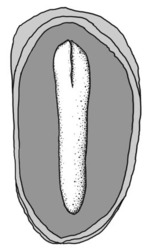 , straight, laterallateral:
, straight, laterallateral:
(of embryo) embryo lies along the side of the seed, generally towards one end; of, at, or from the side; in grasses, can refer to the sides adjacent to the dorsal and ventral sides
, partially filling seed coat. Endospermendosperm:
nutritive starch- and oil-containing tissue present in many seeds
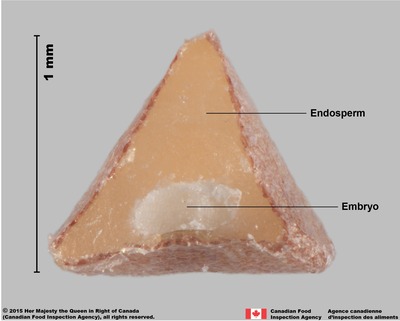 copious, hard.
copious, hard.
| Fruit | |
| Type | capsulecapsule: a dry, dehiscent fruit formed by two or more carpels  |
| Size range | 10–30 mm long |
| Shape(s) | globose, ellipsoidellipsoid: 3D shape—elliptic , oblongoblong: 2D shape—much longer than broad with nearly parallel sides, corners are rounded  , ovoid , ovoid |
| Texture | unknown |
| Surface relief | smooth or ribbedribbed: surface relief—wide, prominent, linear ridges that are generally rounded and longitudinally situated on the surface  , wartywarty: , wartywarty:surface relief—distinct, rounded projections that are large relative to the fruit size; tuberculate, verrucose  , sometimes pubescent , sometimes pubescent |
| Unique features | Usually sticky capsulescapsule: a dry, dehiscent fruit formed by two or more carpels  with numerous red seeds. with numerous red seeds. |
| Seed | |
| Size range | 5–18 mm long |
| Shape(s) | polygonal, cuneiformcuneiform: =wedge-shaped , oblong |
| Surface relief | reticulatereticulate: surface relief—netted, raised walls or concave grooves forming a net-like surface pattern with flat, concave, or convex interspaces  |
| Color(s) | red, black |
| Unique features | Red or black seeds with leatheryleathery: texture—moderately thick, tough, and very pliable or hard, reticulatereticulate: surface relief—netted, raised walls or concave grooves forming a net-like surface pattern with flat, concave, or convex interspaces  seed coats. seed coats. |
| Other | |
| Embryo | well developed, linearlinear: (shape) long, narrow, and uniform in width; (of embryo) embryo is straight and much longer than wide  , straight, laterallateral: , straight, laterallateral:(of embryo) embryo lies along the side of the seed, generally towards one end; of, at, or from the side; in grasses, can refer to the sides adjacent to the dorsal and ventral sides , partially filling seed coat |
| Nutritive tissuenutritive tissue: tissue within the seeds that nourishes the developing embryo; such as endosperm, perisperm, or chalazosperm in angiosperms; megagametophyte in gymnosperms |
endosperm endosperm: nutritive starch- and oil-containing tissue present in many seeds  copious, hard copious, hard |
South America, Africa to Madagascar, Arabia, China.

Distribution map courtesy of Angiosperm Phylogeny Website.
Ayensu 1973Ayensu 1973:
Ayensu ES. 1973. Biological and morphological aspects of the Velloziaceae. Biotropica 5 (3): 135ndash;149. https://doi.org/10.2307/2989806; Baskin and Baskin 2021Baskin and Baskin 2021:
Baskin C and Baskin J. 2021. Relationship of the lateral embryo (in grasses) to other monocot embryos: A status up-grade. Seed Science Research 31 (3): 199-210. doi:10.1017/S0960258521000209; Dahlgren et al. 1985Dahlgren et al. 1985:
Dahlgren RMT, Clifford HT, and Yeo PF. 1985. The families of the monocotyledons: structure, evolution, and taxonomy. Springer-Verlag, Berlin. 520 pp.; Kirkbride et al. 2006Kirkbride et al. 2006:
Kirkbride JH, Jr, Gunn CR, and Dallwitz MJ. 2006. Family guide for fruits and seeds, vers. 1.0. Accessed September 2020ndash;January 2022. URL: https://nt.ars-grin.gov/seedsfruits/keys/frsdfam/index.cfm .; Kubitzki et al. 1990+Kubitzki et al. 1990+:
Kubitzki K et al., eds. 1990+. The families and genera of vascular plants. 7+ vols. Berlin etc.; Smith and Ayensu 1974Smith and Ayensu 1974:
Smith LB and Ayensu ES. 1974. Leaf-anatomy and systematics of Old World Velloziaceae. Kew Bulletin 29 (1): 181ndash;205. https://doi.org/10.2307/4108984; Smith and Ayensu 1975Smith and Ayensu 1975:
Smith LB and Ayensu ES. 1975. Velloziaceae. In: Polhill RM, ed. Flora of Tropical East Africa. Vol 191. Crown Agents for Oversea Governments and Administrations, London UK. 9 pp.
*The number of genera and species is based on Christenhusz and Byng 2016Christenhusz and Byng 2016:
Christenhusz MJM and Byng JW. 2016. The number of known plant species in the world and its annual increase. Phytotaxa 261 (3): 201ndash;217. https://doi.org/10.11646/phytotaxa.261.3.1, which may differ from the number of genera in GRIN-Global.